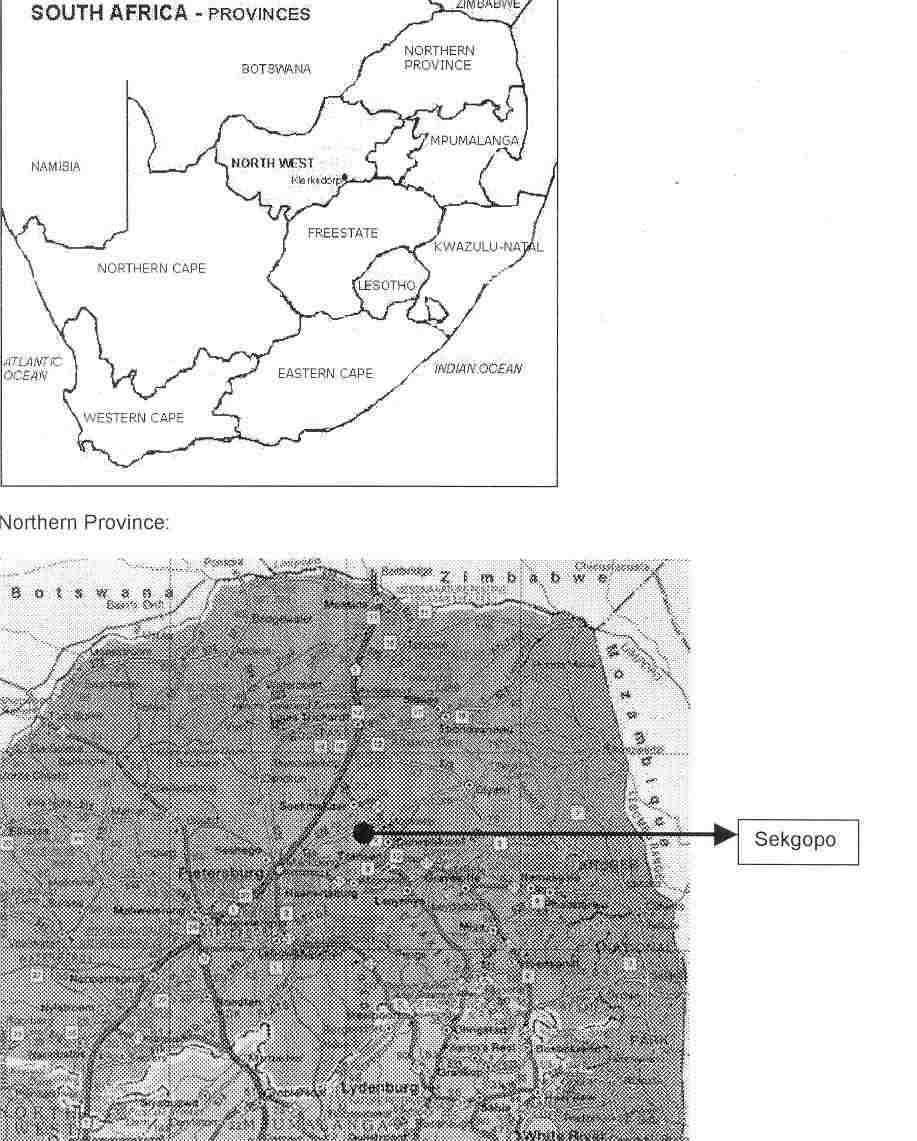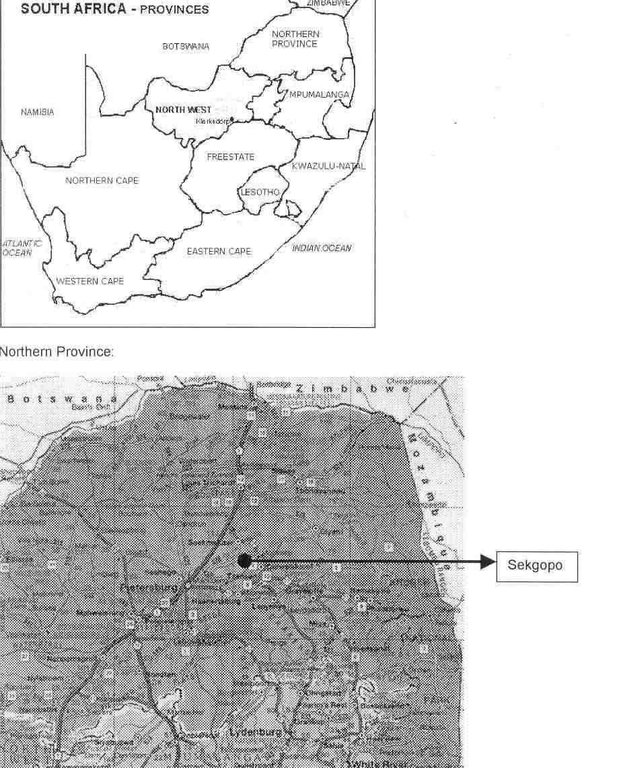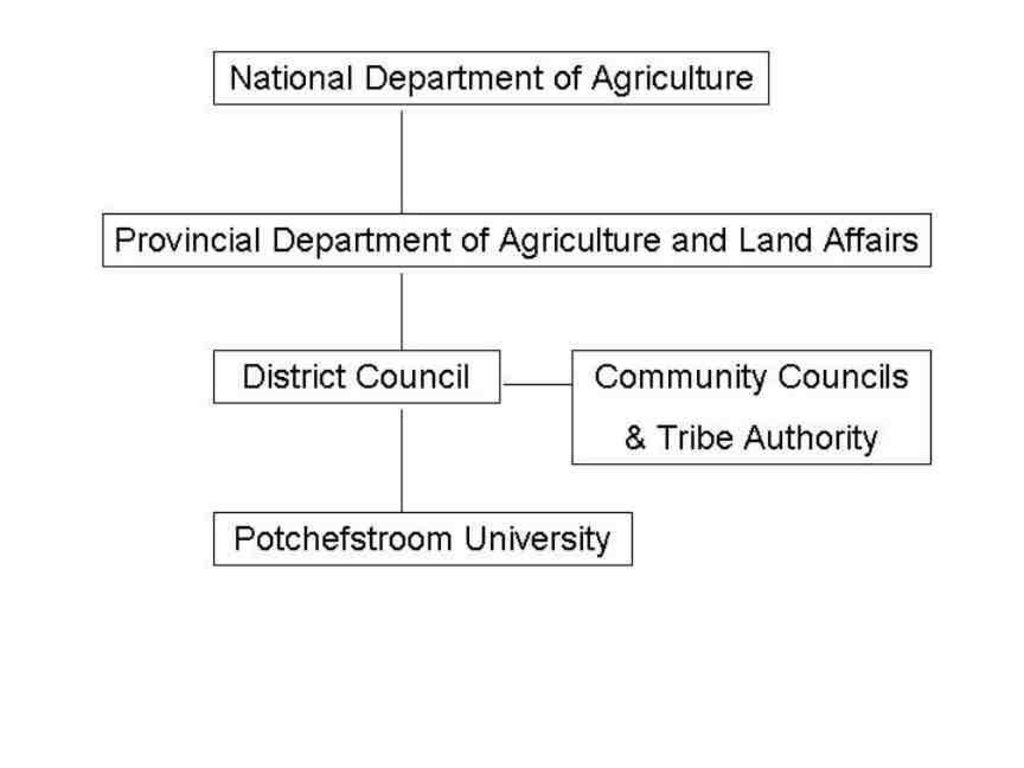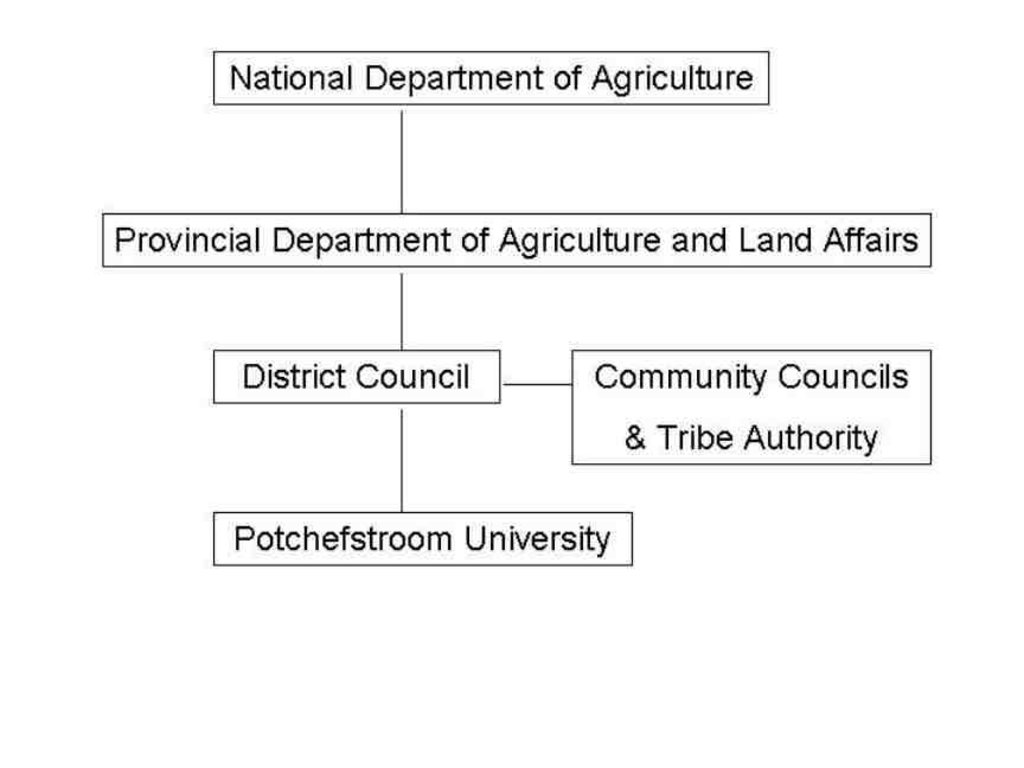Government funded demonstrations [Afrique du Sud]
- Création :
- Mise à jour :
- Compilateur : Klaus Kellner
- Rédacteur : –
- Examinateur : Fabian Ottiger
approaches_2341 - Afrique du Sud
Voir les sections
Développer tout Réduire tout1. Informations générales
1.2 Coordonnées des personnes-ressources et des institutions impliquées dans l'évaluation et la documentation de l'Approche
Spécialiste GDT:
Barac Anushka
Potchefstroom University for Christian Higher Education
Afrique du Sud
Spécialiste GDT:
Van den Berg Loraine
Potchefstroom University for Christian Higher Education
Afrique du Sud
Spécialiste GDT:
J van Rensburg Anja
Potchefstroom University for Christian Higher Education
Afrique du Sud
Spécialiste GDT:
Spécialiste GDT:
Van der Walt Izak
Provincial Soil Conservation Department in Northern Province
Afrique du Sud
Spécialiste GDT:
Monque Augustine
Provincial Soil Conservation Department in Northern Province
Afrique du Sud
Nom du ou des institutions qui ont facilité la documentation/ l'évaluation de l'Approche (si pertinent)
Potchefstroom Universiteit vir CHO (Potchefstroom Universiteit vir CHO) - Afrique du SudNom du ou des institutions qui ont facilité la documentation/ l'évaluation de l'Approche (si pertinent)
Department of Agriculture of Zambia (Department of Agriculture) - ZambieNom du ou des institutions qui ont facilité la documentation/ l'évaluation de l'Approche (si pertinent)
Dept. of Agriculture, Northern Province (Dept. of Agriculture, Northern Province) - Afrique du Sud1.3 Conditions relatives à l'utilisation par WOCAT des données documentées
Le compilateur et la(les) personne(s) ressource(s) acceptent les conditions relatives à l'utilisation par WOCAT des données documentées:
Oui
1.4 Références au(x) questionnaire(s) sur les Technologies de GDT
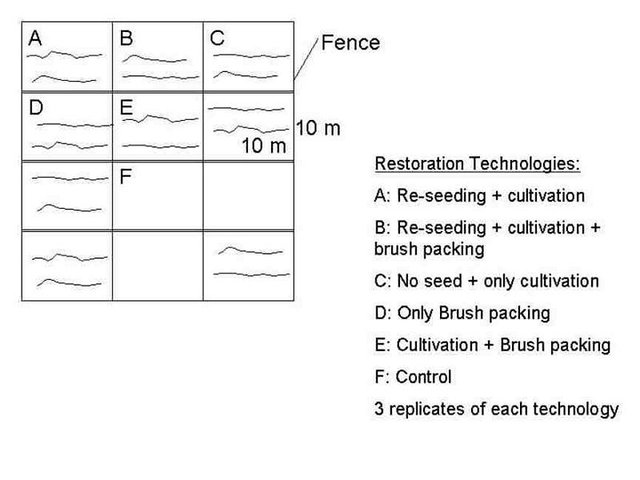
Revegetation and re-seeding [Afrique du Sud]
Revegetation of old, degraded land. Restoring area to increase grazing capacity and production.
- Compilateur : Klaus Kellner
2. Description de l'Approche de GDT
2.1 Courte description de l'Approche
Government funded restoration demonstration site to restore degraded land - by community participation. Community becoming the key sake holders - Capacity building.
2.2 Description détaillée de l'Approche
Description détaillée de l'Approche:
Aims / objectives: Awareness raising and community participation. Capacity building, to teach the aim and type of technologies to the communities with the help of extension workers, scientists and academic staff, including postgraduate students. The main aim is to improve the condition of the land for high grazing capacity and production potential.
2.3 Photos de l'approche
2.5 Pays/ région/ lieux où l'Approche a été appliquée
Pays:
Afrique du Sud
Région/ Etat/ Province:
North West Province
Map
×2.6 Dates de début et de fin de l'Approche
Date (année) de fin de l'Approche (si l'Approche n'est plus appliquée):
2002
2.7 Type d'Approche
- fondé sur un projet/ programme
2.8 Principaux objectifs de l'Approche
The Approach focused mainly on SLM with other activities (Capacity building of SWC technicians and community members.)
Awareness and participation. Training of technologies for restoration. On site or 'On-Farm' technology application.
The SLM Approach addressed the following problems: Restoring degraded land (old lands) by cultivation and oversowing technologies.
2.9 Conditions favorisant ou entravant la mise en œuvre de la(des) Technologie(s) appliquée(s) sous l'Approche
disponibilité/ accès aux ressources et services financiers
- entrave
No money for restoration. Negative cost/benefit ration in short term.
Treatment through the SLM Approach: Apply more cost effective technologies
cadre juridique (régime foncier, droits d'utilisation des terres et de l'eau)
- favorise
The existing land ownership, land use rights / water rights helped a little the approach implementation: Help: land users again appreciated the role and importance of the natural resources. Hinder: lack of land tenure and ownership.
connaissances sur la GDT, accès aux supports techniques
- entrave
No awareness and skills
Treatment through the SLM Approach: Capacity building and job creation. Commitment by stake holders and rural communities assured.
3. Participation et rôles des parties prenantes impliquées dans l'Approche
3.1 Parties prenantes impliquées dans l'Approche et rôles
- exploitants locaux des terres / communautés locales
Specific ethnic groups: Sotho's
Work done and technology carried out by community. Mostly women as they need to earn money for food and household. Community councils; tribal authority - Chiefs make decisions.
- ONG
University helped with implementation of technology
- gouvernement national (planificateurs, décideurs)
Funded mainly by NDA
- organisation internationale
Funds
Si plusieurs parties prenantes sont impliquées, indiquez l'organisme chef de file ou l'institution responsable:
National specialists improved and designed technologies and land users gave inputs with regard to type of area, plants and usage of grazing land.
3.2 Participation des exploitants locaux des terres/ communautés locales aux différentes phases de l'Approche
| Participation des exploitants locaux des terres/ communautés locales | Spécifiez qui était impliqué et décrivez les activités | |
|---|---|---|
| initiation/ motivation | passive | Mainly:public meetings; partly: workshops/seminars |
| planification | passive | Mainly: workshops/seminars; partly: public meetings |
| mise en œuvre | soutien extérieur | Mainly: responsibility for major steps; partly: casual labour |
| suivi/ évaluation | interactive | |
| Research | interactive | on-farm |
3.3 Diagramme/ organigramme (si disponible)
3.4 Prises de décision pour la sélection de la Technologie/ des Technologies
Indiquez qui a décidé de la sélection de la Technologie/ des Technologies à mettre en œuvre:
- principalement les spécialistes de la GDT, après consultation des exploitants des terres
Expliquez:
consultative.
Decisions on the method of implementing the SLM Technology were made by mainly by SLM specialists with consultation of land users. consultative.
4. Soutien technique, renforcement des capacités et gestion des connaissances
4.1 Renforcement des capacités/ formation
Une formation a-t-elle été dispensée aux exploitants des terres/ autres parties prenantes?
Oui
Formats de la formation:
- entre agriculteurs (d'exploitants à exploitants)
- zones de démonstration
- réunions publiques
Thèmes abordés:
Ecological principles; Restoration technologies; NRM principles.
4.2 Service de conseils
Les exploitants des terres ont-ils accès à un service de conseils?
Oui
Spécifiez si le service de conseils est fourni:
- dans les champs des exploitants?
Décrivez/ commentez:
Name of method used for advisory service: Demonstration/Participation; Key elements: 'Learning by Doing'; 1) Mainly: government's existing extension system, Partly: non-governmental agency.
Advisory service is inadequate to ensure the continuation of land conservation activities; Monitoring, data analysis and presenting of results will be conducted by Research staff and project implementation. Expert advice needed on a continuous basis.
4.3 Renforcement des institutions (développement organisationnel)
Des institutions ont elles été mises en place ou renforcées par le biais de l'Approche?
- oui, un peu
Spécifiez à quel(s) niveau(x), ces institutions ont été renforcées ou mises en place:
- local
Précisez le type de soutien:
- renforcement des capacités/ formation
4.4 Suivi et évaluation
Le suivi et l'évaluation font ils partie de l'Approche? :
Oui
Commentaires:
bio-physical aspects were regular monitored through measurements
technical aspects were ad hoc monitored through observations
socio-cultural aspects were ad hoc monitored through observations
economic / production aspects were ad hoc monitored through observations
area treated aspects were regular monitored through measurements
no. of land users involved aspects were regular monitored through measurements
management of Approach aspects were regular monitored through measurements
There were no changes in the Approach as a result of monitoring and evaluation: This was one site establishment for demonstration purposes of technologies.
4.5 Recherche
La recherche a-t-elle fait partie intégrante de l’Approche?
Oui
Spécifiez les thèmes:
- écologie
- technologie
Donnez plus de détails et indiquez qui a mené ces recherches:
Vegetation and soil monitoring/analysis. Application of restoration technologies in demonstration plots.
Research was carried out on-farm
5. Financement et soutien matériel externe
5.1 Budget annuel de la composante GDT de l'Approche
Si le budget annuel précis n'est pas connu, indiquez une fourchette:
- < 2 000
Commentez (par ex. principales sources de financement/ principaux bailleurs de fonds):
Approach costs were met by the following donors: government (national - Agriculture): 80.0%; national non-government (University): 20.0%
5.2 Soutiens financiers/ matériels fournis aux exploitants des terres
Les exploitants des terres ont-ils reçu un soutien financier/ matériel pour la mise en œuvre de la Technologie/ des Technologies?
Oui
5.3 Subventions pour des intrants spécifiques (incluant la main d'œuvre)
- équipement
| Spécifiez les intrants subventionnés | Dans quelle mesure | Spécifiez les subventions |
|---|---|---|
| machines | en partie financé | |
- intrants agricoles
| Spécifiez les intrants subventionnés | Dans quelle mesure | Spécifiez les subventions |
|---|---|---|
| semences | entièrement financé | |
| fertilisants | entièrement financé | |
- matériaux de construction
| Spécifiez les intrants subventionnés | Dans quelle mesure | Spécifiez les subventions |
|---|---|---|
| Fence | entièrement financé | |
Si la main d'œuvre fournie par les exploitants des terres était un intrant substantiel, elle était:
- payée en espèces
Commentaires:
Job-creation incentives
5.4 Crédits
Des crédits ont-ils été alloués à travers l'Approche pour les activités de GDT?
Non
6. Analyses d'impact et conclusions
6.1 Impacts de l'Approche
Est-ce que l'Approche a aidé les exploitants des terres à mettre en œuvre et entretenir les Technologies de GDT?
- Non
- Oui, un peu
- Oui, modérément
- Oui, beaucoup
Oversowing and better soil seed bank; good cultivation methods; certain adapted grass species used.
Land users do not own the land - any SWC application can be of more value and land users will be more committed if they take ownership.
Did other land users / projects adopt the Approach?
- Non
- Oui, un peu
- Oui, modérément
- Oui, beaucoup
Approach will be extended to other rural areas.
6.3 Durabilité des activités de l'Approche
Les exploitants des terres peuvent-ils poursuivre ce qui a été mis en œuvre par le biais de l'Approche (sans soutien extérieur)?
- oui
Si oui, décrivez de quelle manière:
Extension workers have learned the SWC technology from specialists (University researcher) and he/she together with the land user will hopefully extend the technology to larger and other areas on that own. Specialist must however make results available o
6.4 Points forts/ avantages de l'Approche
| Points forts/ avantages/ possibilités du point de vue de l'exploitant des terres |
|---|
| Learned a lot - especially with regard to the restoration process |
| Earned money - job-creation |
| Knowledge about sustainable rangeland management strategies improved |
| School children and teachers involved. School projects on SWC technologies and restoration ecology in particular |
| Points forts/ avantages/ possibilités du point de vue du compilateur ou d'une autre personne ressource clé |
|---|
| Co-operation between all stakeholders (How to sustain/ enhance this strength: By making data and analysis scientifically sound - results better) |
| Land users, technicians/extension, researcher, policy makers |
| SWC technology will be monitored by scientists - value added to project |
6.5 Faiblesses/ inconvénients de l'Approche et moyens de les surmonter
| Faiblesses/ inconvénients/ risques du point de vue de l’exploitant des terres | Comment peuvent-ils être surmontés? |
|---|---|
| Often too long before action is taken | Faster action. Extension better and more committed |
| Linguistic abilities. Land user has another language (Sotho), not spoken by specialist | Take local language classes and learn local language |
| SWC technology application must not only be build on job-creation incentives, but must be sustainable in the long term and applied by land user without payment. |
| Faiblesses/ inconvénients/ risques du point de vue du compilateur ou d'une autre personne ressource clé | Comment peuvent-ils être surmontés? |
|---|---|
| Often too long before action is taken | Faster action. Extension better and more committed |
| Linguistic abilities. Land user has another language (Sotho), not spoken by specialist | Take local language classes and learn local language |
| SWC technology application must not only be build on job-creation incentives, but must be sustainable in the long term and applied by land user without payment. |
7. Références et liens
7.1 Méthodes/ sources d'information
- visites de terrain, enquêtes sur le terrain
- interviews/entretiens avec les exploitants des terres
Liens et modules
Développer tout Réduire toutLiens

Revegetation and re-seeding [Afrique du Sud]
Revegetation of old, degraded land. Restoring area to increase grazing capacity and production.
- Compilateur : Klaus Kellner
Modules
Aucun module trouvé


